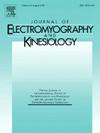Electrical cutaneous stimulation of the foot sole does not enhance rate of torque development during maximal effort isometric plantarflexion in females
IF 2.3
4区 医学
Q3 NEUROSCIENCES
引用次数: 0
Abstract
Rate of torque development (RTD) measures how rapidly one can generate torque and is crucial for balance and athletic performance. Fast RTD depends on the rapid recruitment of high threshold motor units (MUs). Cutaneous electrical stimulation has been shown to alter MU excitability, favoring high threshold MUs via reduced recruitment thresholds. A strong coupling exists between foot sole cutaneous mechanoreceptors and motor neurons of lower-limb muscles, yet it remains unknown if cutaneous input can impact RTD via modulation of MU excitability. This study aimed to investigate whether electrical stimulation across the heel could alter plantarflexion RTD. 11 young and healthy females underwent eight sets of five explosive isometric plantarflexion contractions on a dynamometer while sitting with hip, knee and ankle angles of 80°, 110°, and 90°, respectively. All participants achieved > 95 % voluntary activation of their plantar flexors. Four sets of contractions were performed with heel cutaneous electrical stimulation (1.0 ms pulses delivered at 300 Hz, at 2 × perceptual threshold) and four sets with no stimulation. Instantaneous RTD values were analyzed in 25 ms epochs from onset to 250 ms. No significant differences were observed between stimulation conditions within each epoch, thus our results suggest that electrical cutaneous stimulation does not alter RTD in this population.
足底皮肤电刺激不能提高女性在最大力度等距跖屈时的扭矩发展速度。
扭矩发展速率(RTD)衡量一个人产生扭矩的速度,对平衡和运动表现至关重要。快速RTD依赖于高阈值运动单元(MUs)的快速募集。皮肤电刺激已被证明可以改变MU的兴奋性,通过降低招募阈值而有利于高阈值MU。足底皮肤机械感受器与下肢肌肉运动神经元之间存在强耦合,但皮肤输入是否可以通过调节MU兴奋性来影响RTD尚不清楚。本研究旨在探讨电刺激是否能改变足跟屈曲RTD。11名年轻健康女性分别以髋部、膝关节和踝关节角度为80°、110°和90°坐着,在测力计上进行了8组5次爆发性跖屈收缩。所有参与者的足底屈肌自发活动达到了95%。采用足跟皮肤电刺激(1.0 ms脉冲,300 Hz, 2倍知觉阈值)进行4组收缩,无刺激进行4组收缩。瞬时RTD值在起始至250 ms的25 ms周期内进行分析。在每个时期的刺激条件之间没有观察到显着差异,因此我们的结果表明皮肤电刺激不会改变该人群的RTD。
本文章由计算机程序翻译,如有差异,请以英文原文为准。
求助全文
约1分钟内获得全文
求助全文
来源期刊
CiteScore
4.70
自引率
8.00%
发文量
70
审稿时长
74 days
期刊介绍:
Journal of Electromyography & Kinesiology is the primary source for outstanding original articles on the study of human movement from muscle contraction via its motor units and sensory system to integrated motion through mechanical and electrical detection techniques.
As the official publication of the International Society of Electrophysiology and Kinesiology, the journal is dedicated to publishing the best work in all areas of electromyography and kinesiology, including: control of movement, muscle fatigue, muscle and nerve properties, joint biomechanics and electrical stimulation. Applications in rehabilitation, sports & exercise, motion analysis, ergonomics, alternative & complimentary medicine, measures of human performance and technical articles on electromyographic signal processing are welcome.

 求助内容:
求助内容: 应助结果提醒方式:
应助结果提醒方式:


